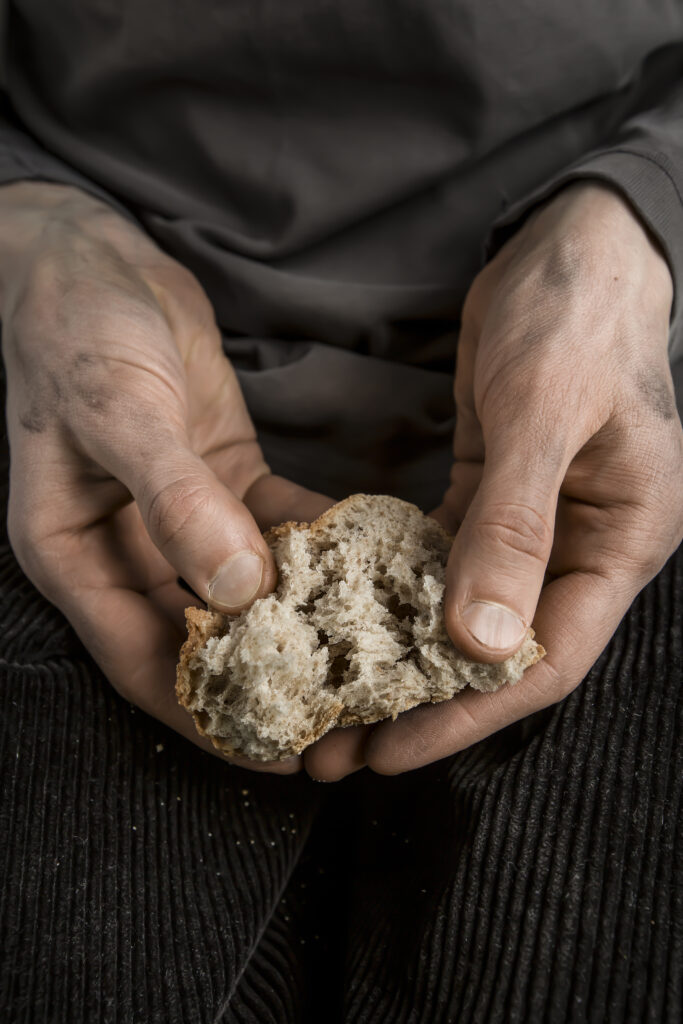12 April 2024
Rising Poverty: Nearly 80% of Impoverished Poles Struggle to Afford Food
Według najnowszego raportu Federacji Polskich Banków Żywności w ciągu ostatniego roku pogorszyła się sytuacja ekonomiczna prawie 78% osób ubogich, które korzystają z bezpłatnej żywności otrzymywanej od organizacji charytatywnych. Przez inflację sześć na dziesięć z nich musi się zapożyczać, żeby samodzielnie kupić jedzenie. Tylko co czwarta osoba może sobie codziennie pozwolić na zjedzenie ciepłego posiłku do syta.
POBIERZ RAPORT "NIEDOŻYWIENIE I GŁÓD W POLSCE"
Pobierz plik
Wyślij link do pobrania do:
According to the latest report by the Federation of Polish Food Banks, the economic situation of nearly 78% of impoverished individuals who rely on free food from charitable organizations has deteriorated over the past year. Due to inflation, six out of ten of them have to borrow money to buy food on their own. Only one in four people can afford a full warm meal every day.
The dramatic picture of the situation of Poles with the lowest incomes emerges from the “Malnutrition and Hunger in Poland” study. The Federation of Polish Food Banks conducted it among people experiencing poverty who turn to non-governmental organizations cooperating with Food Banks for free food packages. In 2022, approximately 1.4 million people benefited from such support.
Today, seniors, children, people with disabilities, and single parents are in the most difficult situation. Contrary to appearances, it is single-parent families, not large families, that are most at risk of malnutrition. Life is particularly difficult for workers earning minimum wage in large cities, where prices of goods and services are highest.
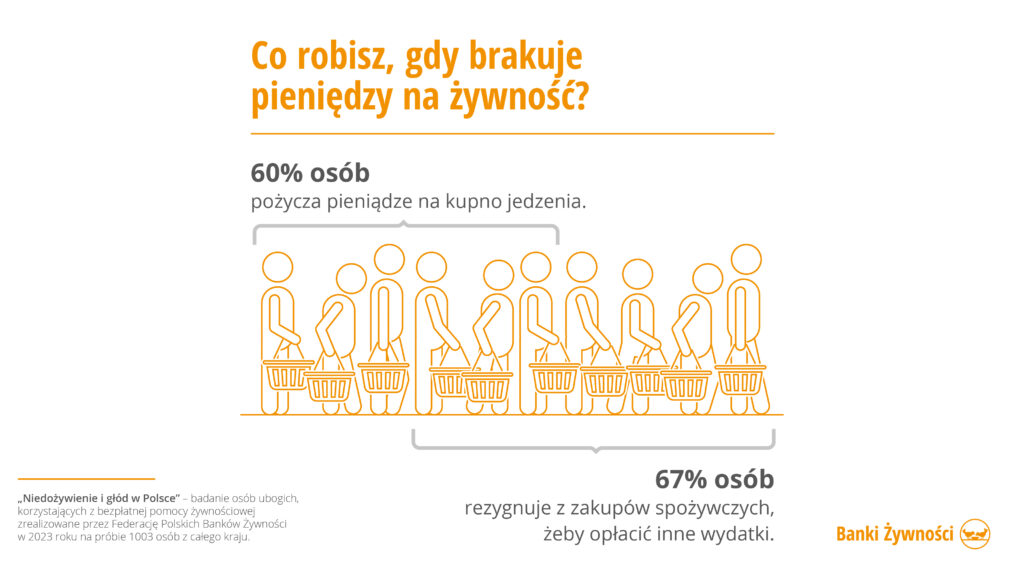
In 53% of households surveyed, there is not enough money to meet basic needs – including buying food. Over 80% of them have experienced hunger due to financial reasons at least once in the past year. In 56% of homes, such a situation occurs regularly. Six out of ten people have to borrow money to buy food. More than two-thirds of respondents had to give up grocery shopping to finance other expenses, such as paying for medication or rent. As a result, entire groups of products disappear from the plates in poor households. To save on food, over 60% of respondents give up fish, 53% give up meat and deli products, and almost 41% give up vegetables. Sugar and sweets, as well as beverages, including coffee and tea, also disappear from the shopping list.
“In 2023, people in Poland are undernourished due to poverty. This is a huge social problem, which unfortunately intensifies with high inflation. The economically disadvantaged still feel the economic effects of the pandemic and war,” says Beata Ciepła, President of the Federation of Polish Food Banks. “By conducting the first comprehensive study on malnutrition in Poland, we wanted to give a voice to those who are in the most difficult economic situation. The issues of the poor are not present in everyday public debate. We want them to become visible and audible.”
Malnutrition has various consequences. It directly affects a person’s well-being, their daily efficiency, and their health. One of its less noticeable effects is the deficiency of minerals, nutrients, and vitamins in the body. This is qualitative malnutrition, which can lead to the development of diseases such as anemia or diabetes. Those most at risk are people who consume low-quality, cheap food. Such products are highly processed and therefore of low nutritional value.
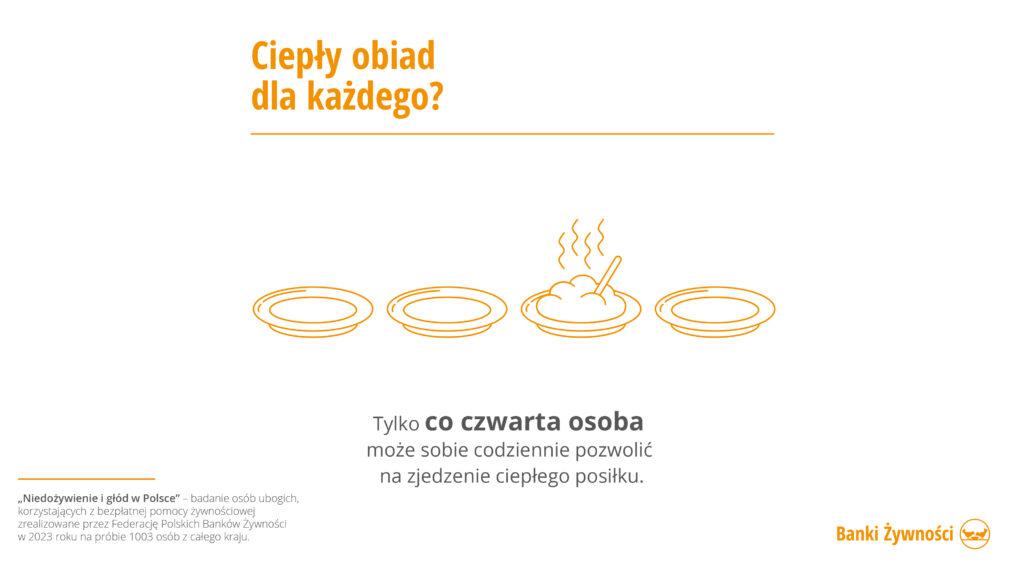
“Paradoxically, the consequence of qualitative malnutrition is overweight and obesity. This also applies to children consuming high-energy, low-nutrient foods, such as snacks and sweets,” says Dr. Marta Czapnik-Jurak, head of the “Malnutrition and Hunger in Poland” study.
The state offers several types of food support: targeted assistance for food purchases, food packages, or ready-made meals. A large part of the food available in this way comes from the EU’s “Operational Food Aid Programme” and the government’s “School and Home Meals Programme for 2019–2023.” To qualify for public assistance, one must meet income criteria, i.e., have income not exceeding the limit set by law. These amounts are adjusted, but their changes do not keep up with inflation. Moreover, different incomes qualify for different types of benefits, which is a bureaucratic obstacle for people applying for assistance.
A significant part of the food support system in Poland is provided by non-governmental organizations, such as Food Banks. Their employees point out that despite their efforts, not all those in need have access to free food. In addition to those who formally qualify for assistance and actually use it, there are also other eligible individuals who do not do so due to various barriers.
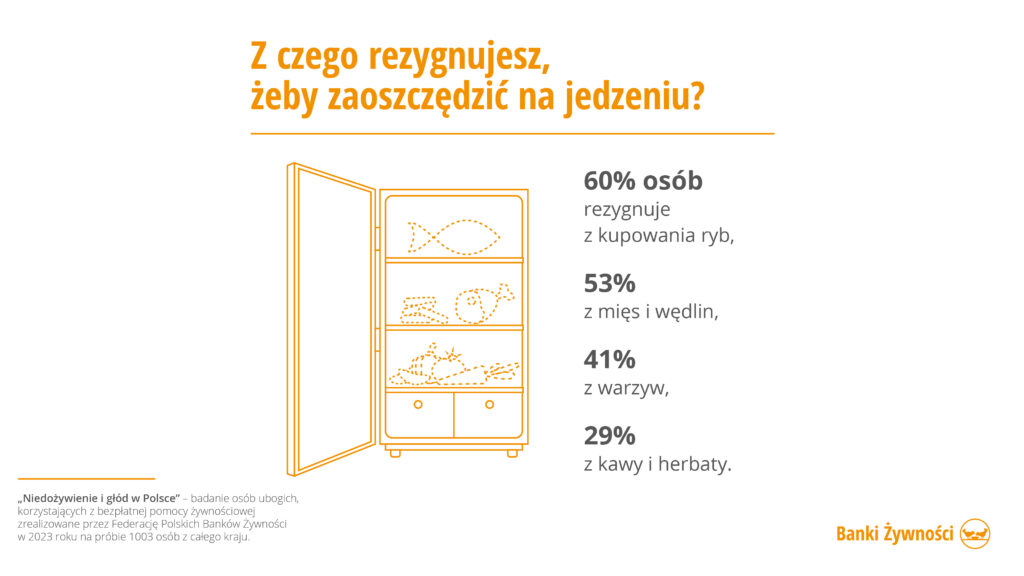
“People often feel ashamed to use this free food. Sometimes they also lack information about where they can get a meal. If they live in rural areas, they often have to travel too far to food distribution points. Unfortunately, formalities are also a barrier, they overwhelm many people,” explains Błażej Krasoń, President of the Food Bank in Wrocław. “The study also shows that these are challenges mainly faced by women, as they feel most responsible for feeding the family. They manage limited finances and organize support from social assistance institutions and charitable organizations. By taking on such tasks, they play the role of ‘poverty managers’ in families.”
Rising living costs mean that more and more needy people are turning to charitable organizations, for whom the existing income criteria may be too low. These are mainly seniors whose pensions exceed income limits, and so-called “working poor.” These are people who receive minimum wages and have high living costs due to commercial rent, for example. After paying the rent, they have very little money left, but formally their incomes exceed the set amounts, so in practice they may have limitations in accessing support.
The needs are enormous because despite the tens of thousands of tons of food distributed each year from Food Banks and offered by other organizations and the state, there are still people in Poland who do not always have enough to eat. It is also paradoxical that on the one hand, households throw away an average of 92 kg of food per year, and on the other hand, the problem of malnutrition is growing among different social groups. It increasingly affects even working people, who were not previously covered by the support system,” notes Beata Ciepła, President of the Federation.
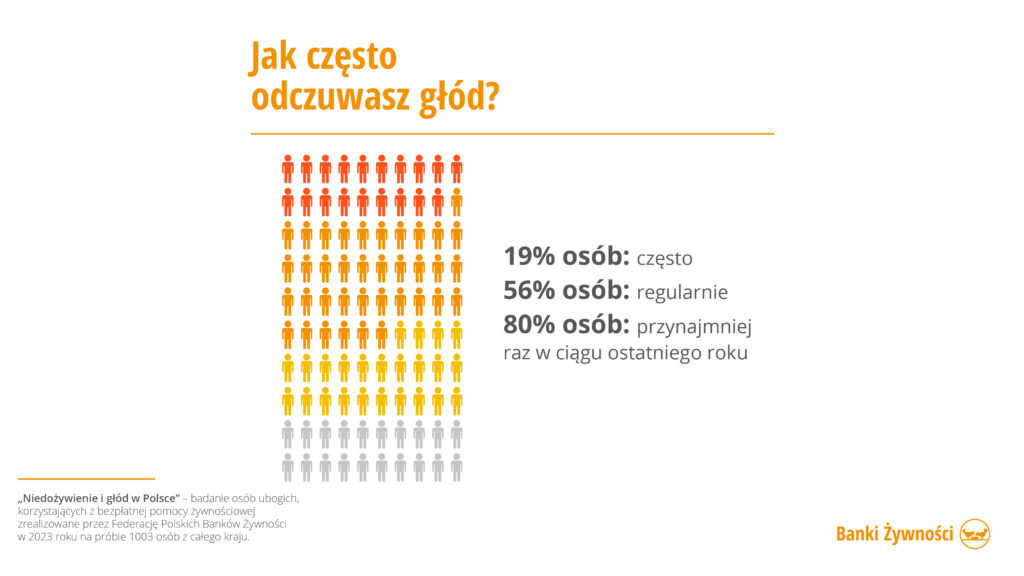
Food Banks are a nationwide network of 31 charitable organizations. For 25 years, they have been acquiring food from businesses (producers, distributors, stores) suitable for consumption with a short shelf life and providing it for free to people in need. Most of the food distributed by Food Banks is food rescued from waste, which would otherwise end up in the trash. From February 2022 to August 2023, Food Banks provided over 67,000 tons of food to people in need.
The quantitative study “Malnutrition and Hunger in Poland” is the first such comprehensive study of the phenomenon in Poland. It was conducted on a sample of 1003 people receiving food assistance in all provinces of the country. It also included online surveys of 635 non-governmental organizations, individual and group interviews with people experiencing poverty, as well as experts.
The activities of the Federation of Polish Food Banks in 2022–24 are co-financed by the Norwegian Funds as part of the Active Citizens Program – National Fund.







